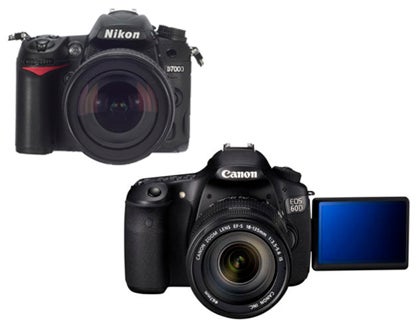Canon EOS 60D vs Nikon D7000: Movie & Value
Canon EOS 60D vs Nikon D7000: Value for money
The D7000 costs around £1300 with a kit lens, around £300 more than the 60D. Such a difference in price may help decide on which to purchase.
Isolate the 60D and it’s very closely sandwiched between the 550D and 7D models – indeed the lower-spec 550D offers much of the specification for a fraction of the price, with the omission of the vari-angle screen and less specified autofocus the most obvious differences.
The Nikon D7000 is relatively closely matched to the D300s, albeit with a less significant build quality and focus system. However this does mean it’s very well specified at its lower price point.
Canon EOS 60D vs Nikon D7000: Movie Modes
Movie modes in DSLRs are becoming as important as still capture for a number of purchasers these days. For tax reasons there are limitations to maximum record time (29mins 59 seconds) as any longer would mean an additional 5% import duty and re-classification as a video (rather than stills) camera in the EU.
Furthermore there’s a limit to 4GB as a maximum file size as this is the largest portion of data that the mandatory FAT-32 file system can deal with.
In addition the larger sensor sizes in stills cameras are potentially prone to overheating when recording, so manufacturers themselves often put yet further caps on record time in order to avoid issues.
And lastly there’s the data rate, i.e. the number of bits of data being transferred per second. The higher this data rate is the potential better the quality will be, but also the shorter the video length will be due to the above restrictions.
The Canon and Nikon movie modes are both well-specified. However the Canon has the upper hand in terms of manual control. There are 24, 25 or 30fps options at Full HD 1080p, compared to the Nikon that offers just 24fps at 1080p. The Canon records shorter clips, but this is for the simple fact that it packs considerably more data (44mbit/sec – almost double the Nikon’s 25mbit/sec bit rate) into the files. The Nikon still performs well, and the company’s choice to move from its previous M-JPEG to newer H.264 compression (output directly as MOV files) is certainly a step in the right direction.
The Canon 60D limits the maximum video length to less than 12mins (at 1080p24), while the D7000 records a maximum clip length of 20mins. Overall the Canon 60D takes the winning ticket for its more advanced options and better movie quality.





